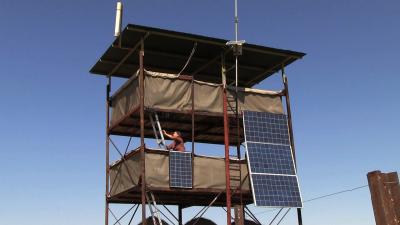Oct 20 2012
A team of elephant researchers from Stanford University has transformed a remote corner of southern Africa into a high-tech field camp run entirely on sunlight. The seasonal solar-powered research camp gives scientists a rare opportunity to quietly observe, videotape and photograph wild elephants at Mushara waterhole, an isolated oasis in Etosha National Park in Namibia.
 "Stanford University researchers are using solar power to operate an elephant field study camp in Namibia's Etosha National Park."
"Stanford University researchers are using solar power to operate an elephant field study camp in Namibia's Etosha National Park."
"One of the really special aspects of solar energy is that it allows us to be in this incredibly remote area that's closed to tourists and is off the grid," said lead researcher Caitlin O'Connell-Rodwell, an instructor at the Stanford School of Medicine and a collaborating scientist at Stanford's Center for Conservation Biology. She is also co-founder of Utopia Scientific, a non-profit organization that promotes awareness about science, conservation and public health.
"We get to watch elephant society unfold before us in a very quiet environment – no generators, no people, no vehicles," she added.
O'Connell-Rodwell has been studying elephant communication at Mushara for 20 years. She was the first scientist to demonstrate that low-frequency calls produced by elephants generate powerful vibrations in the ground – seismic signals that elephants can feel, and even interpret, via their sensitive trunks and feet.
To identify individual elephants, Stanford undergraduate Patrick Freeman took hundreds of high-resolution photographs using a camera run on solar-powered batteries. His trip to Namibia was supported by a travel grant from the Vice Provost for Undergraduate Education (VPUE) at Stanford. Each year, VPUE provides additional funding to support Stanford undergraduates working in the camp.
Solar energy was also used to operate a powerful speaker system that delivered low-frequency sounds to elephants gathered at the waterhole. The solar panels provided enough electricity to run a makeshift elephant dung laboratory, operate camera and editing equipment for a documentary video crew, and power two 12-volt refrigerators stocked with fresh meat, dairy products and beer.
Wildlife on parade
Mushara is home to hundreds of wild animals – including rhinos, giraffes, hyenas and lions – that parade to and from the watering hole 24/7. To keep inquisitive critters from wandering into camp, which operated from June through August this year, researchers installed a solar-powered electric fence around the perimeter that delivered a harmless shock to any animal that got too close. "It will just scare them away," said researcher Tim Rodwell, a Stanford MD who teaches medicine at the University of California-San Diego. "A lion tried to touch the fence in the far corner. He only tried it once."
Solar energy also enabled the Stanford team to stay connected to the Internet – allowing O'Connell-Rodwell to send numerous blog posts to the New York Times website directly from Mushara.
The solar panels and the rest of the electrical system were dismantled at the end of the season when the researchers returned home. O'Connell-Rodwell and her team plan to reconstruct the solar-powered camp at Mushara next year and resume their long-term elephant research project.
"Basically, all of our high-tech electronics are run off of a couple of solar panels, a couple of batteries and an inverter," she said. "The sun does the rest."
The Stanford team also received technical support from solar energy companies Soltec and HNU Energy.